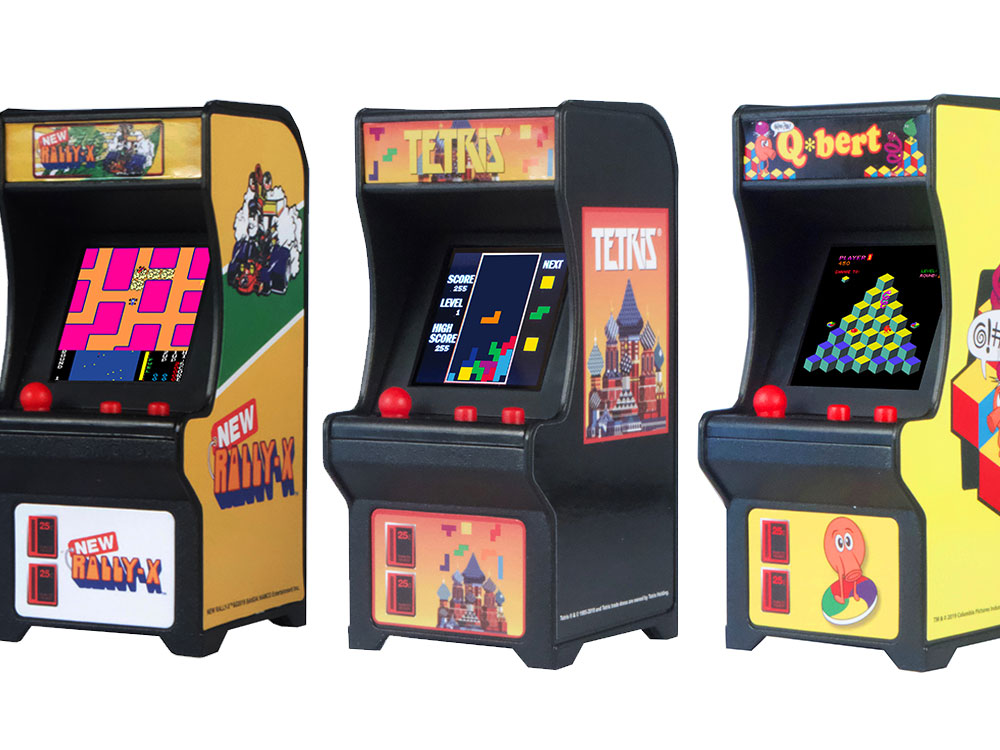
It’s been nearly four decades since a little yellow circle named Pac-Man started gobbling white dots and running from ghosts in arcades all across the U.S. During that time, he — and many other iconic game characters — never really left pop culture, despite the declining popularity of traditional arcades, thanks to a rise in home consoles and mobile gaming.
Yet there’s no denying that these classic games, such as Pac-Man, Frogger, Galaga, and Defender, are making a major comeback, especially in traditional cabinet form. In the past few years, a wide range of arcade machines have popped up for consumer purchase, ranging in size from Arcade 1Up’s 3/4-scale, multi-game cabinets down to Super Impulse’s pocket-sized Tiny Arcade line.
Alan Dorfman, owner of Super Impulse, says the line of miniature arcade cabinets (which launched in 2017 and expands by three or four titles each year) has fans of all ages, ranging from “6-year-olds to those whose short-range vision has started to decline.” Dorfman says the line made sense for Super Impulse because classic toys and entertainment properties in general have become incredibly popular in recent years. “People have an emotional tie to their pasts, and a game, toy, TV show, or movie that made them feel good when they were younger makes them feel good again,” he says, “especially in a pocket-sized version.”
But this yearning for content from decades past isn’t the only factor at play. Christopher Hanson, an English professor at Syracuse University who focuses on game studies and digital media, says the trend is fueled by a few different factors. Yes, he does agree that nostalgia — and the desire to share that nostalgia with a new generation — plays a role. But that isn’t the whole story.
Another interesting cause, he says, is economic. It is significantly easier to license and repurpose a classic game than it is to develop a major new one. “These [arcade] games are profoundly cheap compared to the prohibitive development costs of AAA games today,” he says. “So if you look at how much making a game like the new Assassin’s Creed or Red Dead Redemption 2 costs, … there’s going to be a significant cost differential there.”
In addition to an economic advantage, Hanson says these games provide a unique physical experience. “I think these arcade cabinets are doing something an emulator on your phone or PC could never do,” he says. “You are sort of physically present there in a way that I would argue is impossible if you’re playing it on your phone.”
For players looking for a physical experience even more akin to the traditional arcade setting, there is also a growing number of bar-arcade hybrids, where visitors can order drinks and play classic arcade cabinets. Evan Louis, the general manager at Coin-Op Gaslamp, a bar arcade in San Diego, believes that these bars have influenced and possibly caused the resurgence in the games’ popularity. Every day, he sees some patrons rediscovering games they loved from their youth, while others are discovering the arcade experience for the first time.
“I think there is something captivating about arcades in general,” he says. “They are colorful, bright, and noisy. … It’s always great to see people take a walk down memory lane and smile.”
In addition to coming back as arcade cabinets, many retro games are also expanding to become lifestyle brands. A prime example is Tetris, which celebrated its 35th anniversary last month. This year, the game expanded into a lot of new product categories, such as makeup and even infant products. Tetris isn’t alone in this either: There’s apparel and accessories on the way for other classic games, including Frogger, Bomberman, and Contra.
In the case of Tetris, Megan Buettner, head of consumer products of Blue Planet Software, says the game’s lasting, wide appeal makes it a logical fit for product lines. “There’s a unique connection to every single person who has touched it,” she says. “Everyone gets it.”
Yet, even as fans happily don Tetris socks or download the popular new Tetris 99 game on their Nintendo Switch, there is something special about sitting down to play with a joystick and two buttons.
As Hanson explains it, “just like we may enjoy a super-detailed, really rich novel or film, there’s also a pleasure in the shorter, simpler experiences. For every time I want to play Red Dead Redemption 2 or something like that, there’s also a joy in being able to play something like Q*bert.”
Photo: Super Impulse
This article was originally published in the Pop Insider’s Summer 2019 Issue No. 4, click here to read more!
